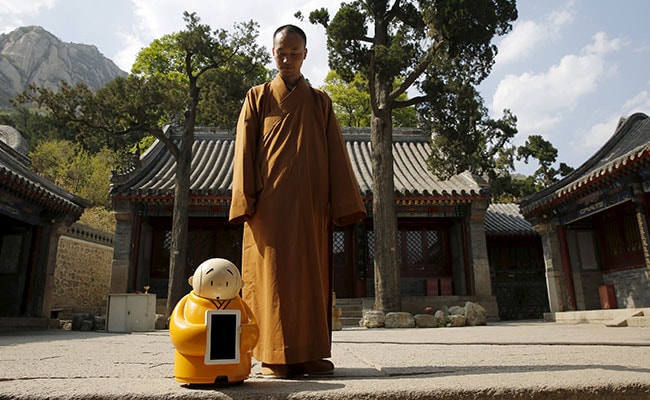
Master Xianfan looks at robot monk Xian'er as he demonstrates the robot's conversation function during a photo opportunity in Longquan Buddhist temple on the outskirts of Beijing. (Reuters Photo)
Buddism may be an ancient religion, but one temple is looking to the future to spread its teachings.
Xian'er makes for a good Buddhist, chanting his mantras with almost endless energy and chatting with interested parties about the intricacies of the religion.
Oh, he's also a robot.
Standing at two feet tall, Xian'er moves around by voice-command and can answer 20 different questions about Buddhism in his version of small talk - comparable to a mini version of Apple's Siri. The topics he can discuss are listed on a screen he holds in front of his considerable heft. He's "clad" in yellow and sports a bald dome with eyebrows raised in perpetual interest (or maybe it's surprise). He calls the Longquan temple on the outskirts of Beijing home, Reuters reported.

Master Xianfan, his creator, based him on a cartoon he began drawing in 2013, which wound up in animations, published comics and merchandise featuring Xian'er's likeness. Both the cartoon and the robot have the same goal: to spread the teachings of Buddhism.
Xian'er has chosen a good time to do so, as Buddhism is currently on the rise. According to research by Pew, the number of Buddhists worldwide is expected to increase to 511 million people by 2030. It was 488 million in 2010.

Xianfan attributes the current rise in Buddhism to harried people seeking peace in a fast-paced digital world.
"Buddhism is something that attaches much importance to inner heart, and pays attention to the individual's spiritual world," he told Reuters. "It is a kind of elevated culture. Speaking from this perspective, I think it can satisfy the needs of many people."
That's where Xian'er comes in: He might be able to spread that inner peace to a digital world. And while this same world has created many of the distractions, Xianfan said it makes sense to mix science and Buddhism.

"Science and Buddhism are not opposing nor contradicting, and can be combined and mutually compatible," he said.
Spreading the religion might be important, too. After peaking in 2030, Buddhism is expected to drop to 486 million by 2050 - falling from 7 percent of the world's population in 2010 to 5 percent in 2050 - due to the average age and low fertility rates of many practicing Buddhists.
The report states, "The proportion of China's population that is Buddhist is expected to remain around 18 percent between 2010 and 2050."
Another Pew study projected that Islam will likely grow faster than any other religion by 2050 if current trends continue. In fact, if the Buddhist population rises and falls as predicted, it will be the only major religion that isn't poised for "at least some growth in absolute numbers."
If Xian'er doesn't get to work, that is.
The little guy has certainly charmed some people. Michelle Yu, a practicing Buddhist who recently visited Beijing, made a special visit to Xian-er, who she first saw on social media.
"He looks really cute and adorable," she told CBC. "He'll spread Buddhism to more people, since they will think he's very interesting, and will make them really want to understand Buddhism."
© 2016 The Washington Post
Xian'er makes for a good Buddhist, chanting his mantras with almost endless energy and chatting with interested parties about the intricacies of the religion.
Oh, he's also a robot.
Standing at two feet tall, Xian'er moves around by voice-command and can answer 20 different questions about Buddhism in his version of small talk - comparable to a mini version of Apple's Siri. The topics he can discuss are listed on a screen he holds in front of his considerable heft. He's "clad" in yellow and sports a bald dome with eyebrows raised in perpetual interest (or maybe it's surprise). He calls the Longquan temple on the outskirts of Beijing home, Reuters reported.

Master Xianfan, his creator, based him on a cartoon he began drawing in 2013, which wound up in animations, published comics and merchandise featuring Xian'er's likeness. Both the cartoon and the robot have the same goal: to spread the teachings of Buddhism.
Xian'er has chosen a good time to do so, as Buddhism is currently on the rise. According to research by Pew, the number of Buddhists worldwide is expected to increase to 511 million people by 2030. It was 488 million in 2010.

Xianfan attributes the current rise in Buddhism to harried people seeking peace in a fast-paced digital world.
"Buddhism is something that attaches much importance to inner heart, and pays attention to the individual's spiritual world," he told Reuters. "It is a kind of elevated culture. Speaking from this perspective, I think it can satisfy the needs of many people."
That's where Xian'er comes in: He might be able to spread that inner peace to a digital world. And while this same world has created many of the distractions, Xianfan said it makes sense to mix science and Buddhism.

"Science and Buddhism are not opposing nor contradicting, and can be combined and mutually compatible," he said.
Spreading the religion might be important, too. After peaking in 2030, Buddhism is expected to drop to 486 million by 2050 - falling from 7 percent of the world's population in 2010 to 5 percent in 2050 - due to the average age and low fertility rates of many practicing Buddhists.
The report states, "The proportion of China's population that is Buddhist is expected to remain around 18 percent between 2010 and 2050."
Another Pew study projected that Islam will likely grow faster than any other religion by 2050 if current trends continue. In fact, if the Buddhist population rises and falls as predicted, it will be the only major religion that isn't poised for "at least some growth in absolute numbers."
If Xian'er doesn't get to work, that is.
The little guy has certainly charmed some people. Michelle Yu, a practicing Buddhist who recently visited Beijing, made a special visit to Xian-er, who she first saw on social media.
"He looks really cute and adorable," she told CBC. "He'll spread Buddhism to more people, since they will think he's very interesting, and will make them really want to understand Buddhism."
© 2016 The Washington Post
Track Latest News Live on NDTV.com and get news updates from India and around the world

